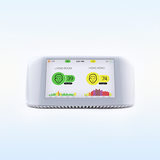Your cart is currently empty.
Nitrogen Oxides (NOx): Source & Health Issues Associated with NOx
Nitrogen Oxides (NOx): Sources & Health Issues Associated with NOx
Learn about the common sources to health hazards. We will uncover the secrets of NOx and provide tips on how to kick it out of your home for good!
Sources of NOx in household
Nitrogen oxides (NOx) can sneak into your home from various sources, contributing to indoor air pollution. One common source is gas stoves and ovens, where the combustion process releases NOx into the air. Additionally, tobacco smoke contains nitrogen compounds that can increase NOx levels indoors.
Another unsuspecting source of NOx in households is vehicle emissions seeping in through open windows or doors, especially in urban areas with heavy traffic. Even using certain household cleaning products or paints can release nitrogen compounds that add to NOx levels inside.
Furthermore, wood-burning fireplaces and stoves are culprits for releasing significant amounts of NOx when not properly ventilated. And let's not forget about gas heaters and furnaces which also emit nitrogen oxides as byproducts of combustion processes.
Health problems associated with NOx exposure
Breathing clean air is essential for our well-being, but exposure to nitrogen oxides (NOx) can pose serious health risks. When NOx reacts with other compounds in the atmosphere, it forms harmful pollutants that can irritate the respiratory system. Long-term exposure to NOx has been linked to an increased risk of asthma, bronchitis, and other respiratory diseases.
Children, elderly individuals, and people with pre-existing conditions are particularly vulnerable to the effects of NOx exposure. Inhaling these pollutants can also worsen existing cardiovascular problems and lead to decreased lung function over time.
Reducing indoor sources of NOx through proper ventilation and using appliances that produce fewer emissions can help minimize health issues associated with NOx exposure. It's crucial to prioritize clean air in our homes for our overall health and well-being.
How to reduce NOx levels in your home
Reducing NOx levels in your home is crucial for maintaining good indoor air quality and promoting overall health. One effective way to decrease NOx emissions is by ensuring proper ventilation throughout your living space. Opening windows regularly allows fresh air to circulate, diluting any pollutants present.
Another method to reduce NOx levels is by using household products that are labelled as low or no VOC (volatile organic compounds). These products emit fewer harmful gases into the air, thus minimizing NOx production indoors.
Regular maintenance of gas appliances like stoves and heaters can also help lower NOx emissions. Ensuring these appliances are functioning properly and not leaking gas will prevent unnecessary release of nitrogen oxides into your home environment.
Investing in an air purifier with a HEPA filter can also be beneficial in reducing NOx levels by trapping particles that contribute to indoor pollution. Additionally, incorporating houseplants known for their air-purifying properties can further improve indoor air quality and reduce nitrogen oxide concentrations in your home.
Government regulations on NOx emissions
Government Regulations on NOx Emissions play a crucial role in protecting public health and the environment. Various agencies, such as the Environmental Protection Agency (EPA) in the United States, have set limits on NOx emissions from different sources like vehicles, power plants, and industrial facilities. These regulations aim to reduce air pollution levels and improve air quality standards for everyone.
By enforcing stricter emission standards, governments can hold industries accountable for their contribution to NOx pollution. In many countries, there are penalties for non-compliance with these regulations to ensure that companies take necessary measures to control their emissions effectively.
Monitoring systems are put in place to track NOx levels in the atmosphere and ensure that they remain within permissible limits. Regular inspections of facilities are conducted to check for compliance with emission standards set by regulatory bodies.
It's important for individuals and businesses alike to be aware of these regulations and take proactive steps toward reducing their own NOx emissions. By working together with government initiatives, we can all contribute to creating a cleaner and healthier environment for future generations.
Conclusion and final thoughts
Understanding the sources and health effects of nitrogen oxides (NOx) in household settings is crucial for creating a healthier indoor environment. By implementing simple strategies like proper ventilation, regular maintenance of appliances, and using air purifiers, you can significantly reduce NOx levels in your home.
Remember that improving indoor air quality not only benefits your health but also contributes to a cleaner environment. Stay informed about government regulations on NOx emissions and do your part to minimize pollution at home.
With these tips in mind, you can create a safe and healthy living space for you and your family. Take proactive steps to reduce NOx exposure and enjoy clean, fresh air indoors. Your well-being is worth the effort!


















